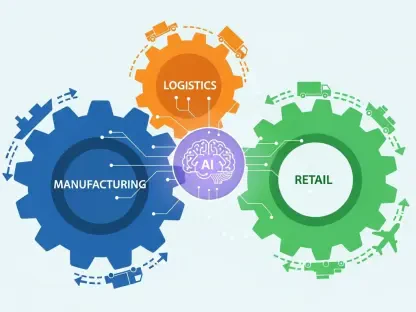As Apple continues to solidify its foothold in the enterprise IT sector with record Mac adoption and business-oriented platform updates, a critical question emerges: are these advancements enough to meet the complex needs of corporate environments? Despite the company’s impressive strides in blending user-friendly design with robust security, insights from industry experts reveal lingering gaps that could hinder its full potential in business settings. Apu Pavithran, CEO of a leading device management vendor, has pinpointed specific challenges that Apple must tackle to better support IT administrators. His observations highlight a tension between Apple’s traditionally controlled ecosystem and the diverse, often unpredictable demands of enterprise workflows. This discussion delves into these critical areas, exploring how addressing them could elevate Apple’s standing among IT professionals tasked with managing sprawling device fleets in high-stakes industries.
Navigating the Enterprise IT Landscape with Apple
In today’s corporate world, Apple’s presence is undeniable, with devices increasingly integrated into workplaces ranging from tech startups to healthcare facilities. The appeal lies in a seamless user experience paired with strong security features, making Macs, iPads, and iPhones go-to choices for many organizations. However, beneath this polished surface, IT administrators often grapple with limitations that can disrupt efficiency and compliance. The insights shared by industry leaders point to a broader trend: while Apple has adapted significantly to business needs, certain pain points persist that require targeted solutions. These challenges are not mere inconveniences but represent fundamental areas where enterprise requirements clash with Apple’s design philosophy. Understanding these issues is essential to appreciating the balance Apple must strike between innovation and practicality in corporate environments.
The conversation around Apple’s role in enterprise IT often centers on the need for greater administrative control and flexibility. IT teams managing large-scale deployments must navigate strict regulatory demands and diverse user scenarios, which can expose gaps in Apple’s current offerings. Whether it’s ensuring data privacy in shared settings or accommodating unique software needs, the pressure is on to provide tools that empower rather than constrain. Industry feedback suggests that while Apple has made notable progress with features tailored for business use, the path forward lies in addressing specific, high-impact concerns. These concerns, raised by experts familiar with device management challenges, offer a roadmap for Apple to refine its platforms and deepen trust among enterprise clients.
Fine-Tuning AI with Granular Permissions
Apple Intelligence, the company’s on-device AI framework, stands out as a promising tool for enhancing productivity while prioritizing privacy—a critical factor for enterprise adoption. Yet, a significant challenge arises in environments handling sensitive data, such as financial institutions or medical facilities, where universal application of AI features could pose risks. IT administrators need the ability to toggle these capabilities on a per-app basis, ensuring that tools like text summarization or predictive suggestions are only active where appropriate. This level of control would prevent unintended data exposure and align AI usage with strict compliance requirements, addressing a key concern for businesses operating under tight regulations.
Beyond selective activation, there’s a pressing need to link AI personalization to individual users rather than devices, particularly in shared setups. When multiple employees access the same hardware, tying insights to authenticated profiles rather than the machine itself prevents data crossover and maintains the relevance of AI outputs. This adjustment would be a game-changer in settings where devices change hands frequently, ensuring that sensitive information remains tied to the correct individual. Such a shift would not only bolster security but also enhance user trust, reinforcing Apple’s reputation as a privacy-focused leader. Addressing this pain point could set a new standard for how AI integrates into enterprise ecosystems with minimal risk.
Bolstering Shared Device Management
Shared devices are a cornerstone of operations in industries like education, healthcare, and retail, where hardware is often used by multiple individuals in quick succession. Apple has introduced features like Shared iPad and Return to Service to support these scenarios, yet gaps remain in delivering the granular control IT teams crave. Administrators seek more robust options to dictate session behaviors and wipe processes across operating systems like iOS, macOS, and visionOS. A unified approach to shared device management would streamline workflows in high-turnover environments, reducing the manual effort required to reset or reconfigure hardware after each use and minimizing downtime for critical operations.
Further refinement could come through pre-staging apps and settings based on user roles, alongside automated return-to-service mechanisms. Imagine a hospital tablet that instantly resets to a neutral state after a nurse logs out, or a classroom device preloaded with specific tools for each student group—these capabilities would cut IT friction significantly. Enhanced session isolation is also vital to safeguard privacy, ensuring that no residual data lingers between users. By addressing these needs, Apple could transform shared device usage from a logistical headache into a seamless asset, empowering organizations to maximize device utility while upholding stringent security standards.
Tackling Non-App Store App Management
A persistent hurdle for enterprise IT lies in managing applications that aren’t sourced from the Apple App Store, a common scenario in specialized fields like logistics and healthcare where proprietary software reigns. While upcoming features like version-pinning for App Store apps mark progress in controlling updates, they offer no solution for these external tools. IT teams are left without adequate mechanisms to oversee or secure such apps, creating potential vulnerabilities and management headaches. As regulatory shifts introduce third-party app stores, the complexity of maintaining oversight only grows, underscoring the urgency for Apple to adapt its ecosystem to these realities.
One potential fix lies in developing a dedicated framework that allows enterprises to distribute and manage non-App Store apps through Apple’s infrastructure or equivalent tools. Such a system would provide the same level of control and security as App Store offerings, ensuring consistency across all software in use. This approach would not only simplify IT responsibilities but also align with the diverse sourcing needs of businesses, many of which rely on custom solutions unavailable through standard channels. Bridging this gap could position Apple as a more versatile partner for enterprises navigating an increasingly fragmented app landscape, reinforcing its commitment to meeting niche demands.
Charting a Path Toward Greater Customization
The recurring theme across these challenges is a clear demand for customization, as IT administrators seek tools to mold Apple’s platforms to specific organizational needs without sacrificing the inherent benefits of its ecosystem. Whether it’s fine-tuning AI features, optimizing shared device protocols, or accommodating unique app requirements, the call for flexibility resonates strongly. These pain points, while distinct, collectively point to an opportunity for Apple to deepen its enterprise appeal by prioritizing administrative control alongside its signature focus on security and user experience. Tackling these issues head-on could elevate Apple from a strong contender to an indispensable ally in corporate tech.
Looking back, Apple’s journey in the enterprise space reflects a steady commitment to addressing business needs, with each platform update bringing incremental improvements. The critiques raised by industry experts serve as valuable guideposts, illuminating areas where refinement is most needed. Moving forward, the focus should shift to actionable strategies—developing granular controls, unifying shared device protocols, and crafting inclusive app management solutions. By embracing these priorities, Apple can not only resolve lingering frustrations but also pave the way for broader adoption in diverse industries, ensuring its technology remains a cornerstone of enterprise innovation for years to come.









